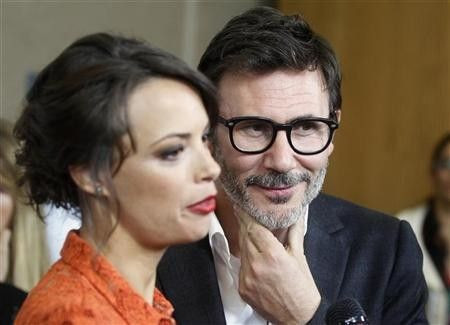Silence is golden in The Artist

You don't have to endure the current onslaught of Republican presidential debates to appreciate the appeal of silence. The movies, in their first several decades of existence, had no soundtrack at all, and millions of people still flocked to see them.
So while Martin Scorsese tips his movie-nerd beret to special-effects pioneer George Melies in Hugo -- and while the major studios threaten to completely replace 35mm film with digital projection, over the objections of repertory theaters and cinema lovers everywhere -- let us praise the mute and monochromatic delights of The Artist.
In his valentine to Ye Olde Hollywood and the era in which movies learned to talk, writer-director Michel Hazanavicius goes all in, making his film not just silent and black-and-white, but also framed in the old 4:3 aspect ratio. (Back in the silent era, that pesky soundtrack didn't occupy any real estate on the film strip.)
Mind you, The Artist isn't just a clever homage to old movies -- that would be fun for maybe 20 minutes. This is a charming, sweet, funny and sad tale of silent star George Valentin (Jean Dujardin), who sees his career go into eclipse when talkies become the rage, and of his discovery, Peppy Miller (Berenice Bejo), who climbs the ladder to fame as her mentor begins to sink.
And if this all sounds like A Star is Born crossed with Singin' in the Rain, it absolutely is -- with a little Sunset Blvd. and even Citizen Kane thrown in for good measure.
If you're gaga for old movies, then you'll certainly eat up The Artist with a celluloid spoon. From its dead-on recreations of 1920s Hollywood (and Hollywood movies) to its evocation of the great movie stars of yore, you'll swoon over Hazanavicius' obvious affection for the subject matter.
What's most exciting about The Artist is that it's a crowd-pleaser even if you aren't steeped in film lore. As the old posters used to promise, it's got Comedy! Romance! Thrills! (As well as one of the most charming trained dogs you've ever seen on the big screen.)
There's certainly a possibility that the low-key, subtle charms of The Artist are going to be overpraised in some quarters, whether by film critics patting themselves on the back for getting the references or by audiences who've never seen a silent movie before and think they're watching the genre being invented before their eyes. (The same thing happened when people who had never watched a Tsui Hark or Sammo Hung movie saw Crouching Tiger, Hidden Dragon and assumed that wire-work martial arts sprang out of Ang Lee's head like Zeus giving birth to Athena.)
Dujardin -- who's mostly unknown in this country, but is a huge star in France for films like Hazanvicius' cloak-and-dagger parody OSS 117: Cairo, Nest of Spies -- looks and acts like the lost Fairbanks; his Jazz Age swagger feels completely natural, and he inhabits the role so completely that it's easy to believe we're watching a performer from that era.
And while Bejo brings her own radiance and can-do energy to her role as a plucky up-and-coming starlet, she doesn't scan visually as an ingenue of the early talkies. Her appearance might have gotten her cast as what they used to call an exotic type, but I didn't buy her as an above-the-title star of the era. It all boils down to her looks, yes, but in a silent movie, the face is everything.
Hazanavicius loads up the supporting cast with performers who look like they're having a ball -- and who would have had solid careers in pictures even if they'd been born 90 years earlier -- including John Goodman, Missi Pyle, Beth Grant, James Cromwell and Penelope Ann Miller.
Ideally, The Artist will be a gateway drug that will let contemporary audiences (kids and adults alike) know that silent movies can be hilarious, moving, scary, exciting and just as entertaining as any of today's blockbusters. So if you, or someone you know, has always shied away from silents, let The Artist show you what you've been missing.
© Copyright Thomson Reuters {{Year}}. All rights reserved.





















